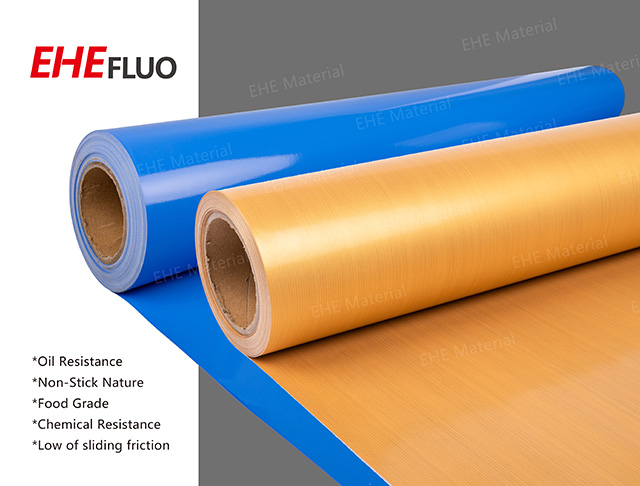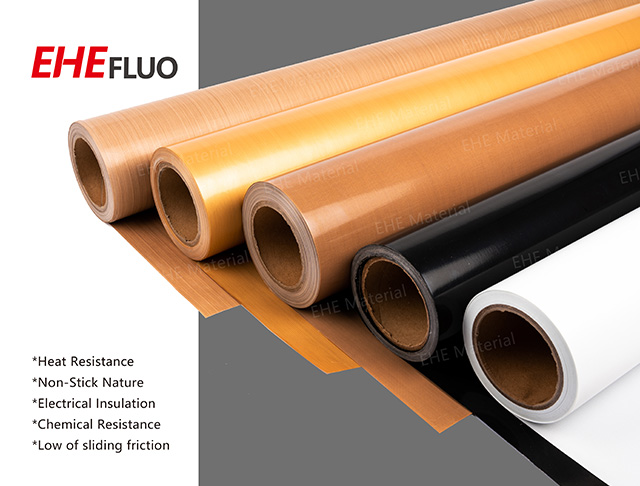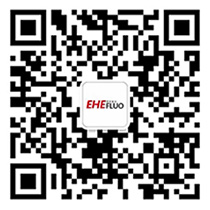What are the different types of PTFE coated fiberglass fabrics?
Update time: 2025-05-23 Views: 763
Description
PTFE (polytetrafluoroethylene) coated fiberglass fabrics are versatile materials renowned for their heat resistance, chemical inertness, and non-stick properties. These fabrics, engineered by combining a woven fiberglass substrate with a PTFE coating, come in multiple variants tailored to specific industrial, commercial, and specialized applications. Below is a detailed breakdown of the primary types, their unique attributes, and how to select the right option for your needs.
1. Standard PTFE Coated Fiberglass Fabrics
Characteristics:
Temperature Range: Withstands continuous temperatures up to 500°F (260°C).Thickness: Typically ranges from 0.08mm to 1.5mm.
Surface: Smooth PTFE coating on one or both sides.
Advantages:
Cost-effective solution for general-purpose applications.
Excellent non-stick surface for easy release of adhesives, resins, and food products.
Flexible at room temperature for easy handling.
Typical Applications:
Food Industry: Baking mats, conveyor belts for freezers, dryers, and ovens.
Packaging: Heat-sealing bars and release sheets for laminating processes.
Textiles: Non-stick liners for ironing and dyeing machines.
2. High-Temperature PTFE Coated Fabrics
Characteristics:Temperature Resistance: Endures short-term exposure up to 600°F (315°C).
Reinforced Construction: Thicker fiberglass weave or additional PTFE layers for durability.
Advantages:
Ideal for extreme heat environments like aerospace composites curing or metal processing.
Resists degradation from thermal cycling.
Typical Applications:
Aerospace: Mold release sheets for carbon fiber composite curing.
Automotive: Heat shields and exhaust system insulation.
Metalworking: High-temperature conveyor belts for annealing furnaces.
3. Antistatic (Conductive) PTFE Coated Fabrics
Characteristics:Surface Resistance: Embedded conductive fibers or coatings to dissipate static electricity (10⁶–10⁹ ohms/sq).
PTFE Coating: Maintains non-stick properties while preventing static buildup.
Advantages:
Critical for explosive environments or electronics manufacturing.
Reduces dust attraction in cleanrooms.
Typical Applications:
Electronics: ESD-safe conveyor belts for PCB assembly.
Chemical Plants: Liners for tanks handling flammable liquids.
Pharmaceuticals: Anti-static release films for tablet compression.
4. Heavy-Duty PTFE Coated Fabrics
Characteristics:Thicker Fiberglass Base: Up to 1.5mm thickness for enhanced tear resistance.
Dual-Coated PTFE: PTFE on both sides for double-sided protection.
Advantages:
Withstands abrasion, punctures, and heavy loads.
Longer lifespan in high-stress applications.
Typical Applications:
Construction: Architectural membranes for tensile structures.
Mining: Wear-resistant liners for chutes and hoppers.
Agriculture: Durable covers for grain drying systems.
5. Silicone-Adhesive Backed PTFE Fabrics
Characteristics:Pressure-Sensitive Adhesive (PSA): Silicone adhesive layer for easy bonding to metals, plastics, or other fabrics.
Release Liner: Protective paper backing for adhesive until application.
Advantages:
Simplifies installation in hard-to-reach areas.
Reusable and leaves no residue upon removal.
Typical Applications:
Heat Sealing: Adhesive-backed gaskets for packaging machinery.
Automotive: Insulation pads for under-hood components.
HVAC: Ductwork seals resistant to moisture and chemicals.
6. Food-Grade PTFE Coated Fabrics
Characteristics:FDA Compliance: Approved for direct contact with food (FDA 21 CFR 177.1550).
Smooth Finish: Easy-to-clean surface for hygiene-critical environments.
Advantages:
Non-toxic and resistant to oils, fats, and acids.
Withstands repeated washdowns and sterilization.
Typical Applications:
Baking: Non-stick oven liners and dough sheeting belts.
Meat Processing: Conveyor belts for smoking and cooking chambers.
Confectionery: Release sheets for chocolate and candy molds.
7. Double-Sided PTFE Coated Fabrics
Characteristics:PTFE Coating on Both Sides: Provides uniform non-stick properties on both surfaces.
Symmetrical Construction: Balanced performance for dual-sided exposure.
Advantages:
Ideal for applications requiring release on both sides, such as laminating presses.
Reduces material waste by eliminating the need for separate liners.
Typical Applications:
Composite Manufacturing: Release films for prepreg curing.
Printing: Double-sided plates for offset printing presses.
Textiles: Calender rolls for synthetic fabric finishing.
How to Choose the Right PTFE Coated Fiberglass Fabric?
Temperature Requirements:Select high-temperature variants for applications exceeding 500°F (260°C).
Chemical Exposure:
Confirm compatibility with acids, solvents, or bases using a chemical resistance chart.
Mechanical Stress:
Opt for heavy-duty types if abrasion or puncture resistance is critical.
Static Control:
Choose antistatic grades for electronics or explosive environments.
Regulatory Compliance:
Verify FDA or REACH certifications for food/medical use.
Customization:
Work with manufacturers for tailored thicknesses, widths, or adhesive options.
Maintenance and Longevity
Cleaning: Use mild detergents and soft brushes to avoid scratching the PTFE surface.Inspection: Regularly check for tears or coating delamination.
Storage: Keep rolls flat in dry conditions to prevent warping.
Conclusion
PTFE coated fiberglass fabrics offer a spectrum of solutions for industries demanding reliability in harsh conditions. By understanding the nuances of each type—from high-temperature resistance to antistatic properties—you can optimize performance, safety, and cost-efficiency in your applications. Whether you’re designing a heat-resistant conveyor system or a food-safe processing line, the right PTFE fabric ensures durability and precision.Previous: PTFE Coated Fiberglass Fabrics: The Ultimate Guide to High-Performance Materials
Next: Innovative application and advantages of PTFE belt in food production line



